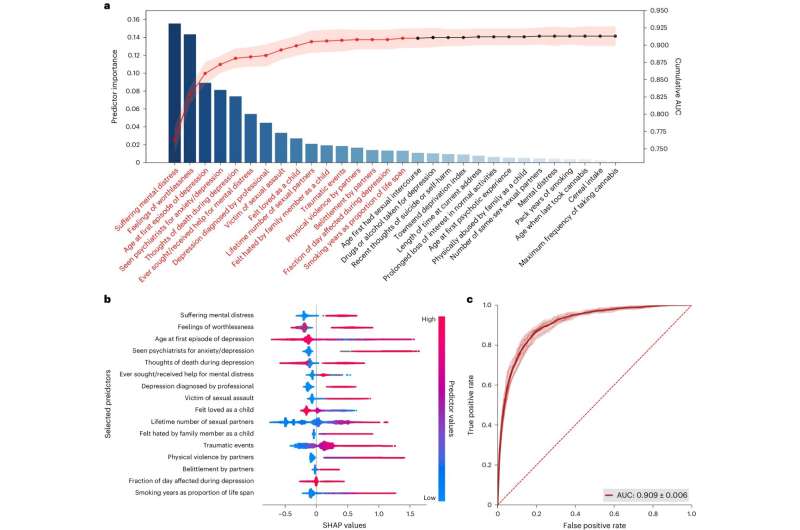This article has been reviewed according to Science X's editorial process and policies. Editors have highlighted the following attributes while ensuring the content's credibility:
fact-checked
peer-reviewed publication
trusted source
proofread
Wide-ranging study identifies suicide risk factors to improve prevention

In the largest study of its kind, scientists at the University of Warwick have investigated a range of contributing risk factors for suicide—helping to identify individuals who might benefit from interventions.
The behavioral and biological predictors, include elevated white blood cells, neuroticism, childhood experiences and reduced gray matter in the brain. Previous research had focused on much smaller sample groups and on fewer risk factors—potentially overlooking some impactors.
It is hoped that the research will tackle the global challenge of suicide—a leading cause of deaths worldwide. According to the World Health Organization, more than 700,000 people die from suicide every year.
The study also helps to identify individuals most at risk, who could be targeted for preventive treatments—such as those suffering mental distress and feelings of worthlessness—by GPs. By using data from more than 500,000 participants from the UK Biobank, a population-based study cohort, its broader approach provides a wider understanding of risk factors, to contribute to more effective preventions.
The team used a variety of methods to investigate suicidal risk factors, including brain scans, blood samples and questionnaires. This led to more than 400 behaviors (including smoking), biological factors (such as amount of gray matter in the brain), and genetics being investigated. A type of artificial intelligence known as machine learning was used to comprehensively analyze the huge dataset.
The paper is published in the journal Nature Human Behaviour.
Factors that associated with suicide included suffering from mental distress, neuroticism, lower gray matter in the brain, size of the emotional regulation areas of the brain and increased white blood cells. The study highlighted how these vastly different influencers could contribute to suicidal behaviors.
Study author Professor Jianfeng Feng, Department of Computer Science, University of Warwick, said, "Our study developed a machine learning model based on behavioral factors. The top 16 predictors showed high accuracy in distinguishing individuals, both with and without suicide attempts. This may be useful in identifying people at high risk of suicide in the future.
"The top behavioral predictors, in addition to the few related to mental illness and depression, are childhood experiences and survivors of sexual assault. These factors provide potential actionable targets for clinicians to develop better prevention strategies."
Co-Author Dr. Bei Zhang, Fudan University, added, "Suicide is a major public health concern that arises from a complex interplay of various factors. While existing research has often focused on a narrow set of behavioral hypotheses often within small clinical samples, our study fills the gap by systematically assessing a broad range of risk factors for suicide attempts in large, community-based samples.
"By identifying and understanding these factors, we hope to improve predictive models, better identify those at risk, and inform more effective prevention and intervention strategies, ultimately reducing the global burden of suicide."
Professor Barbara Sahakian from the University of Cambridge commented, "Suicide is a tragic loss of life, but it also leaves family and friends devastated. By identifying key risk factors for suicide, this study brings us closer to understanding how we might identify vulnerable individuals and intervene to save lives."
For future research, the team emphasized the need for a similar determination of the risk factors for suicide in adolescents, especially as suicide in adolescence is on the increase.
More information: Bei Zhang et al, Identifying behaviour-related and physiological risk factors for suicide attempts in the UK Biobank, Nature Human Behaviour (2024). DOI: 10.1038/s41562-024-01903-x




















